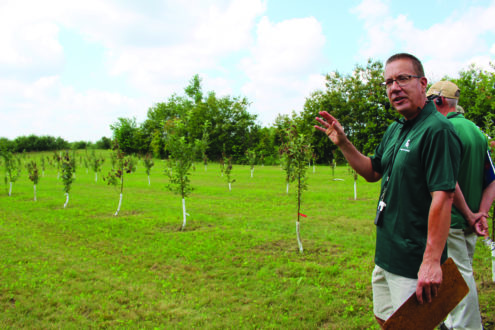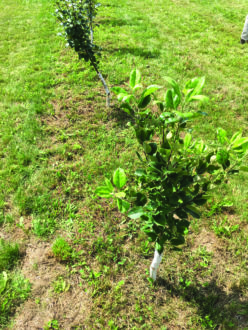

Jun 21, 2018Trials test disease resistance of cider apple varieties
A set of trials at Michigan State University (MSU) is testing cider apples for toughness against scab and fire blight.
MSU researcher George Sundin said more years of trials are needed before he reports the results in full. But he did give Michigan growers a peek at the preliminary results during the 2018 Northwest Michigan Orchard and Vineyard Show.
During the 2017 trials, 30 apple varieties were inoculated with apple scab and fire blight at the MSU campus in East Lansing. Sundin’s collaborator on the study is MSU Extension Specialist Nikki Rothwell, who grows apples and makes cider in northwest Michigan with her husband, Dan Young. The first year of the project was funded by the United States Association of Cider Makers and the Michigan Apple Committee.


“The goal was to check these out and just allow the disease to run rampant at our site in East Lansing – which is far away from most commercial orchards – let the diseases run and then see where we are with the susceptibilities,” Sundin said.
Ten trees of each variety were planted. The mix of 30 varieties included, for comparison, two varieties with documented disease weaknesses – Ginger Gold for fire blight and McIntosh for scab.
The vast majority of the 30 varieties in the trial didn’t show resistance to both diseases. Some of the late-leafing apple varieties escaped an early bout of apple scab but were later susceptible to fire blight. Almost all of the cultivars got shoot infections of fire blight, and the few that didn’t were among the worst for scab.
Only two of the varieties showed resistance to both diseases. GoldRush is a cross of Golden Delicious developed by the cooperative breeding program of Indiana, Illinois and New Jersey Agricultural Experiment stations in the 1990s. Liberty is a red apple introduced in 1978, first raised at the New York State Agricultural Experiment Station.
Sundin noted that even those two varieties have peculiarities that may not make them a good fit for all cider growers. GoldRush has a late harvest date at the end of October, which makes it difficult to sell at fresh markets. Liberty apples, too, have their drawbacks: “Flat-out, they just don’t taste as good as other commercial varieties,” Sundin said.
“I wouldn’t consider them classic cider varieties,” Rothwell said of GoldRush and Liberty. But she added that she recently tasted a single-variety cider of GoldRush and found it to be OK.
Currently, cider growers are blending juice from a large variety of processing, dessert and culinary apples to make hard cider, while experimenting with specialty apple cider varieties that are often more difficult to tend.
“A lot of these English varieties and other hard-cider type varieties, they are hard to grow,” Sundin said. “I think some cider growers are making them out of more traditional apples.”
One example of a difficult cider apple, is Kingston Black, an English bittersharp apple prized for single-variety ciders. In Rothwell’s personal experience, Kingston Black “is a pain to grow,” only generating a decent crop one season out of the past decade.
Rothwell said many of the English and French varieties she’s grown for cider have difficulty handling winters in the northern Midwest.
“I think a lot of us are still blending,” she said.


But Sundin said being hard to grow or disease susceptible doesn’t necessarily rule out apple cider varieties from being planted. In the end, it’s the customers who will decide.
“Growers’ plantings are driven by what’s going to sell,” Sundin said. “It remains to be seen whether these English varieties are going to be more popular.”
The trial will be repeated in 2018, and a third year will test how well the varieties withstand the diseases with the assistance of moderate and high intensive disease control, Sundin said.
Rothwell said the goal is to get the number of potential cider varieties down from 30 to 10. A shortened list would not only take some of the guesswork out of growing cider apples, it would simplify operations for the nurseries that currently supply cider apple growers with a full spread of different seedlings.
“The nursery industry is like, ‘You guys got to get it together,’” Rothwell said. “No one has a really good idea of what grows well.”
– Stephen Kloosterman, FGN Assistant Editor
Top photo: George Sundin, Michigan State University professor in the Department of Plant, Soil and Microbial Sciences, points out scab and fire blight in a cider apple tree trial. Photos: Gary Pullano














